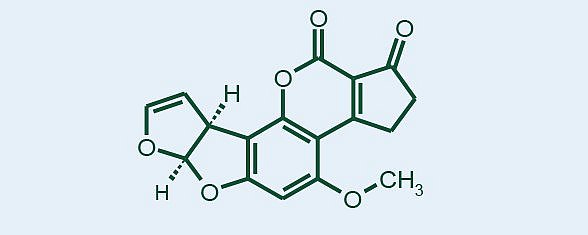What is Aflatoxin?

A group of toxins, consisting primarily of aflatoxin B1, aflatoxin B2, aflatoxin G1, aflatoxin G2 and aflatoxin M1, are named for their respective innate fluorescent properties.
Production and occurrence
The major fungus producing aflatoxins is Aspergillus flavus. However, another fungus, Aspergillus parasiticus and a few other minor species of Aspergillus can also produce these toxins. Aspergillus parasiticus is especially important in peanuts. Not all strains of a given species are capable of aflatoxin production.
When grain such as corn is growing and there is warm ambient temperature (day >32°C; night >24°C), especially noted during drought conditions, the grain becomes more susceptible to aflatoxin formation. These stressful conditions are more prevalent in hot and dry environments (e.g. the southern United States, but can also occur in the Midwest (Corn Belt)). The organism survives in spores (conidia), which are carried by wind or insects to the growing crop. Any condition that interferes with the integrity of the seed coat allows the organism to gain entry into individual kernels. Insects such as sap beetles carry the organism into the developing ears especially those damaged by corn earworms and European corn borers. The two latter insects can carry the organism into plants as well. Corn, cottonseed, peanuts and tree nuts are the main crops affected.
Yellow-green spore masses may be visible at sites of kernel damage or may follow an insect feeding path. If heavily damaged kernels are cracked open by hand and examined under a black light (long wave, 365 nm) they may fluoresce bright greenish-yellow (BGYF). This fluorescence is due to a kojic acid derivative formed by the organism that produces aflatoxin and therefore provides only a “presumptive” indication of the presence of aflatoxin and is not to be used as a positive test for aflatoxin. Individual kernels of corn may contain as high as 400,000 ppb (μg/kg) of aflatoxin, therefore, sampling is very important in analysis for levels of contamination in bulk grain lots.
Grains stored under high moisture/humidity (>14%) at warm temperatures (>20 ºC) or/ and inadequately dried can potentially become contaminated. Grains must be kept dry, free of damage and free of insects; these conditions can result in mold “hot spots”. Initial growth of fungi in grains can form sufficient moisture from metabolism to allow for further growth and mycotoxin formation.
Toxicity
Aflatoxins can cause liver disease in animals, they are also carcinogenic with aflatoxin B1 being the most potent carcinogen (WHO, 2002). Susceptibility varies with breed, species, age, dose, length of exposure and nutritional status. Aflatoxins may cause decreased production (milk, eggs, weight gains, etc.), are immunosuppressive, carcinogenic and mutagenic. Aflatoxins can be present in milk, meat, or eggs if consumed levels are sufficient. Aflatoxin B1 is a human carcinogen and may play a role in the etiology of human liver cancer as speculated by Williams et al. (2004). Ammoniation and some adsorbents will reduce or eliminate the effects of aflatoxins, but can only be applied for animal feedingstuff and in certain countries or within specific states.
Published on:
Mycotoxin